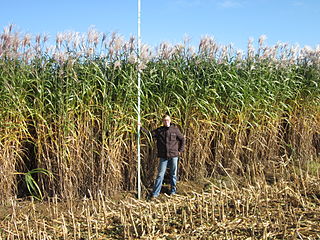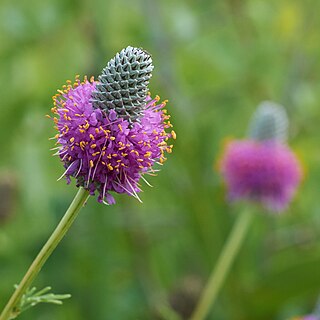
Rhizobia are diazotrophic bacteria that fix nitrogen after becoming established inside the root nodules of legumes (Fabaceae). To express genes for nitrogen fixation, rhizobia require a plant host; they cannot independently fix nitrogen. In general, they are gram negative, motile, non-sporulating rods.

Rhizobium is a genus of Gram-negative soil bacteria that fix nitrogen. Rhizobium species form an endosymbiotic nitrogen-fixing association with roots of (primarily) legumes and other flowering plants.

An endophyte is an endosymbiont, often a bacterium or fungus, that lives within a plant for at least part of its life cycle without causing apparent disease. Endophytes are ubiquitous and have been found in all species of plants studied to date; however, most of the endophyte/plant relationships are not well understood. Some endophytes may enhance host growth, nutrient acquisition and improve the plant's ability to tolerate abiotic stresses, such as drought, salinity and decrease biotic stresses by enhancing plant resistance to insects, pathogens and herbivores.

Miscanthus, or silvergrass, is a genus of African, Eurasian, and Pacific Island plants in the grass family.

Miscanthus sinensis, the eulalia or Chinese silver grass, is a species of flowering plant in the grass family Poaceae, native to eastern Asia throughout most of China, Japan, Taiwan and Korea.

Miscanthus × giganteus, also known as the giant miscanthus, is a sterile hybrid of Miscanthus sinensis and Miscanthus sacchariflorus. It is a perennial grass with bamboo-like stems that can grow to heights of 3–4 metres (13 ft) in one season. Just like Pennisetum purpureum, Arundo donax and Saccharum ravennae, it is also called elephant grass.
Burkholderia vietnamiensis is a species of bacteria. It can be found as an opportunistic pathogen in patients with cystic fibrosis or other immunocompromising illnesses. It differs from most Burkholderia species in that it is often susceptible to aminoglycosides, but not polymyxin B. Many isolates have been found to be catalase positive. B. vietnamiensis is able to fix N
2.
Microbial inoculants also known as soil inoculants or bioinoculants are agricultural amendments that use beneficial rhizosphericic or endophytic microbes to promote plant health. Many of the microbes involved form symbiotic relationships with the target crops where both parties benefit (mutualism). While microbial inoculants are applied to improve plant nutrition, they can also be used to promote plant growth by stimulating plant hormone production.

Spartina pectinata is a species of cordgrass known as prairie cordgrass, freshwater cordgrass, tall marshgrass, and sloughgrass. It is native to much of North America, including central and eastern Canada and most of the contiguous United States except for the southwestern and southeastern regions. Its distribution extends into Mexico. It is also present on other continents as an introduced species.

Bradyrhizobium japonicum is a species of legume-root nodulating, microsymbiotic nitrogen-fixing bacteria. The species is one of many Gram-negative, rod-shaped bacteria commonly referred to as rhizobia. Within that broad classification, which has three groups, taxonomy studies using DNA sequencing indicate that B. japonicum belongs within homology group II.

Citrobacter freundii is a species of facultative anaerobic gram-negative bacteria of the family Enterobacteriaceae. The bacteria have a long rod shape with a typical length of 1–5 μm. Most C. freundii cells generally have several flagella used for locomotion, but some do not and are non-motile. C. freundii is a soil organism, but can also be found in water, sewage, food and in the intestinal tracts of animals and humans. The genus Citrobacter was discovered in 1932 by Werkman and Gillen. Cultures of C. freundii were isolated and identified in the same year from soil extracts.
Soil microbiology is the study of microorganisms in soil, their functions, and how they affect soil properties. It is believed that between two and four billion years ago, the first ancient bacteria and microorganisms came about on Earth's oceans. These bacteria could fix nitrogen, in time multiplied, and as a result released oxygen into the atmosphere. This led to more advanced microorganisms, which are important because they affect soil structure and fertility. Soil microorganisms can be classified as bacteria, actinomycetes, fungi, algae and protozoa. Each of these groups has characteristics that define them and their functions in soil.

Dalea purpurea is a species of flowering plant in the legume family known as purple prairie clover. Native to central north America, purple prairie clover is a relatively common member of the Great Plains and prairie ecosystems. It blooms in the summer with dense spikes of bright purple flowers that attract many species of insects.
Herbaspirillum autotrophicum is a bacterium which cannot fix nitrogen under laboratory conditions, like Herbaspirillum seropedicae, because it does not have the Nif gene.
Herbaspirillum lusitanum is a nitrogen-fixing bacterium found in root nodules of common beans. Phylogenetic analyses have shown this bacterium belongs to the genus Herbaspirillum. H. lusitanum lacks the nif gene. A nodD-like gene is present, but no other nod genes have been identified. The lack of nif and nod genes suggests H. lusitanum is an opportunistic bacterium capable of colonizing root nodules, but is unable to fix nitrogen.
Herbaspirillum rubrisubalbicans is a nitrogen-fixing bacterium of the genus Herbaspirillum found in roots and stems of sugarcane, sorghum, and rice. H. rubrisubalbicans can cause symptoms of the mottled stripe disease in sugarcane and sorghum. Leaves inoculated with H. rubrisubalbicans show red stripes along the secondary veins of the leaf blade.
Herbaspirillum aquaticum is a bacterium of the genus Herbaspirillum.

Azospirillum brasilense is a well studied, nitrogen-fixing (diazotroph), genetically tractable, Gram-negative, alpha-proteobacterium bacterium, first described in Brazil by the group of Johanna Döbereiner and then receiving the name "brasilense". A. brasilense is able to fix nitrogen in the presence of low oxygen levels, making it a microaerobic diazotroph. An isolate from the genus Azospirillum was isolated from nitrogen poor soils in the Netherlands in 1925, however the species A. brasilense was first described in 1978 in Brazil, since this genus is widely found in the rhizospheres of grasses around the world where it confers plant growth promotion. Whether growth promotion occurs through direct nitrogen flux from the bacteria to the plant or through hormone regulation is debated. The two most commonly studied strains are Sp7 and Sp245, both are Brazilian isolates isolated from Tropical grasses from Seropedica, Brazil.
Azospirillum doebereinerae is a species of nitrogen-fixing bacteria associated with the roots of Miscanthus species. Its type strain is GSF71T.
Azospirillum is a Gram-negative, microaerophilic, non-fermentative and nitrogen-fixing bacterial genus from the family of Rhodospirillaceae. Azospirillum bacteria can promote plant growth.









